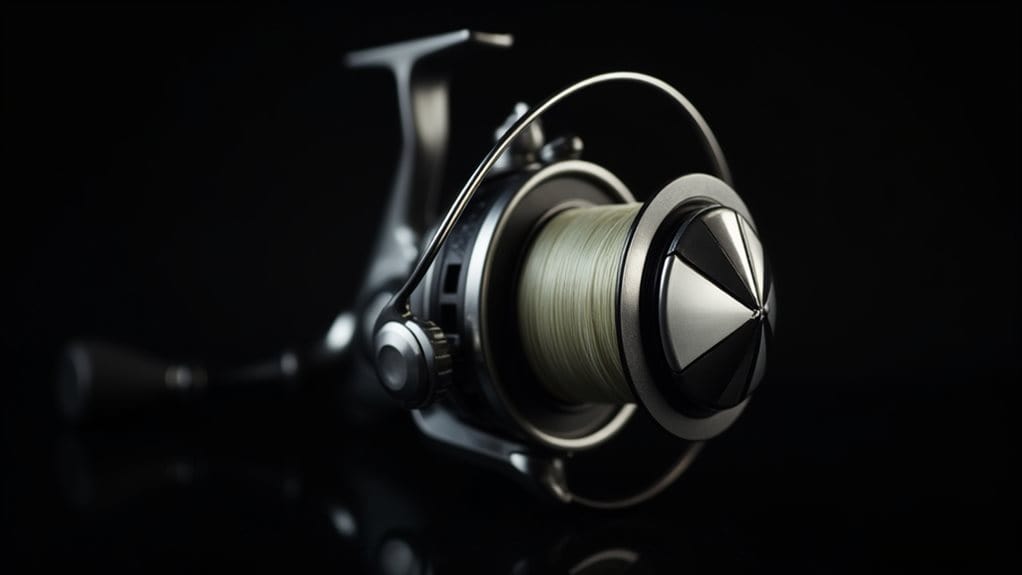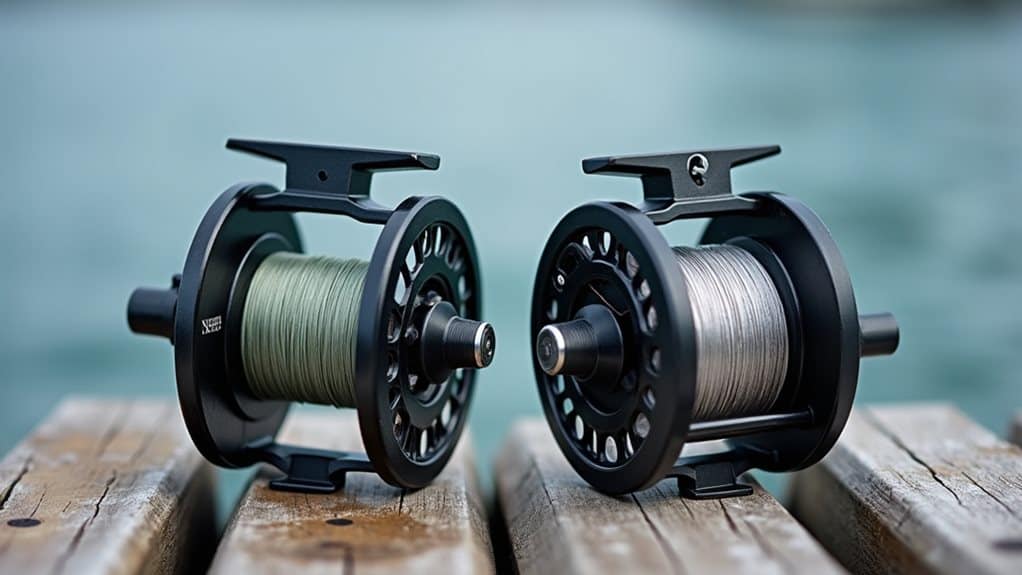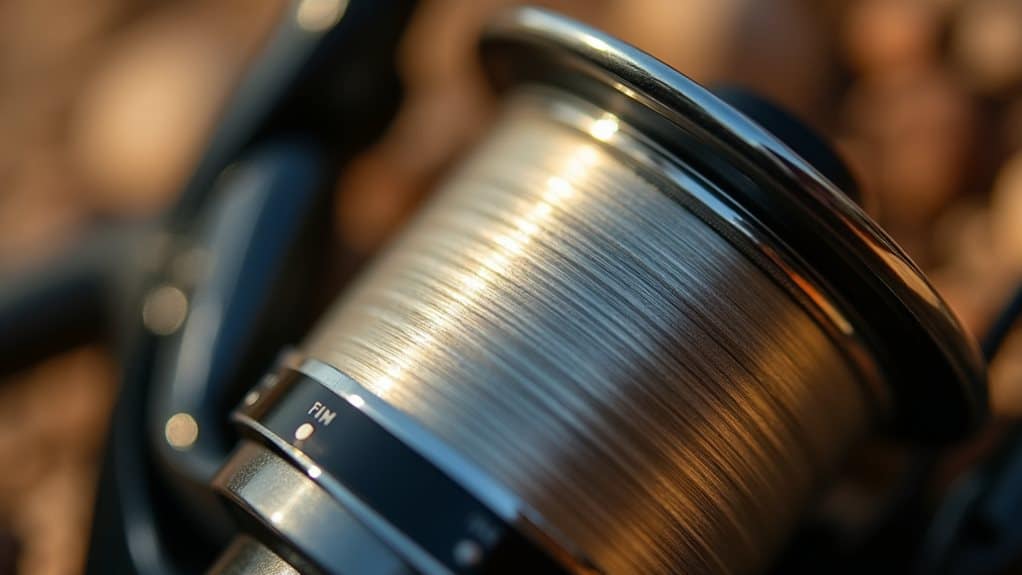You’ll achieve ideal reel performance by maintaining a precise 1/8-inch gap between your line and the spool rim, a standard that balances maximum casting distance with tangle prevention across both spinning and baitcasting setups. This sweet spot prevents wind knots while ensuring sufficient line capacity for long casts and fish runs. Overfilling reduces accuracy through uncontrolled line release, while underfilling limits your casting distance and overall performance. Understanding these principles will help you fine-tune your setup for specific fishing conditions.
TLDR
- Leave approximately 1/8 inch gap between line and spool rim for optimal casting distance and tangle prevention.
- Fill spinning reels to 1/8 inch from rim; baitcasting reels can handle slightly more line capacity.
- Match line weight to fishing type: 10-20 lb for inshore, 50-100 lb for offshore applications.
- Overfilling reduces casting accuracy while underfilling limits distance and lure performance significantly.
- Consider monofilament’s 25% stretch factor when determining line amount for hook-setting power and sensitivity.
Optimal Line Gap Standards for Spinning Reels

One of the most critical factors in achieving ideal casting performance with your spinning reel is maintaining the proper gap between your line and the spool’s outer rim.
The widely recommended standard is approximately 1/8 inch, which effectively balances casting distance with tangle prevention. This gap prevents wind knots while ensuring you’ve got sufficient line for peak performance. Additionally, understanding fish finder technology can help you better analyze underwater structures, enhancing your overall fishing strategy.
For advanced anglers specifically targeting maximum distance, a slightly tighter gap of just under 1/16 inch can provide additional casting advantages.
Line Capacity Guidelines for Baitcasting Reels
Baitcasting reels require a more refined approach to line capacity than their spinning counterparts, as the spool design and casting mechanics create different performance demands. You’ll want to fill low-profile reels to about 1/8 inch from the spool rim, while round-profile models can handle slightly more line due to their larger capacity and different weight distribution. Different size classes offer varying line capacities, with smaller 100-size reels holding around 300 yards of monofilament while larger 300-size models can accommodate up to 400 yards. Proper line capacity is crucial for achieving optimal performance during fishing, ensuring that you can effectively cast and retrieve your bait.
Inshore Vs Offshore Line Requirements

Inshore fishing typically requires 10-20 lb test lines for species like redfish and snook, while offshore fishing demands heavier 50-100 lb test lines to handle larger pelagic fish like tuna and marlin. Additionally, the choice of rod and reel combos can greatly influence the effectiveness of your line choice and overall fishing success.
How Line Amount Affects Casting Distance and Accuracy
Getting the right amount of line on your reel directly impacts how far and accurately you can cast, with the sweet spot being that essential 1/8-inch gap between your line and the spool lip.
You’ll find that overfilling reduces accuracy by creating uncontrolled line release, while underfilling limits your casting distance and makes your lure fall short of the target.
The key is finding the ideal balance where your spool fill maximizes both distance and precision, though you’ll often need to prioritize one over the other depending on your fishing situation. Additionally, understanding fishfinder GPS combos can enhance your overall fishing strategy by helping you locate optimal fishing spots.
Optimal Spool Fill Levels
Why does the amount of line on your reel matter so much for casting performance?
You’ll achieve ideal results by filling your spool to just below the lip, which minimizes friction and guarantees smooth line release.
This precise fill level maximizes casting distance and accuracy while preventing common issues like wind knots and erratic line ejection during your cast.
Distance Vs Accuracy Trade-Offs
When you’re deciding how much line to put on your reel, you’ll face a fundamental trade-off between casting distance and accuracy that every angler must maneuver.
Maximizing distance requires nearly full spools, but this can compromise precision through increased backlash potential.
Slightly reducing line below capacity improves cast control and accuracy while sacrificing minimal distance, especially beneficial for targeted presentations.
Understanding Line Stretch Impact on Performance

When you’re spooling your reel, understanding how different line types stretch under load becomes essential for optimizing your fishing performance.
Monofilament can stretch up to 25% under pressure, which means that 100 feet of mono might extend to 125 feet when you’re fighting a fish, greatly reducing the force you can apply during hooksets.
You’ll need to compensate for this stretch by adjusting your technique, using more aggressive hooksets with mono compared to low-stretch alternatives like braided line.
Monofilament Stretch Characteristics
Understanding monofilament’s stretch characteristics becomes essential for making informed decisions about line capacity and fishing performance.
Monofilament typically stretches up to 25% under pressure, which affects hook-setting power and sensitivity. This stretch acts as shock absorption, preventing hook tears and compensating for drag errors.
Different formulations offer varying stretch levels, allowing you to match line properties to specific fishing conditions.
Compensating for Line Stretch
Line stretch greatly impacts your fishing performance, affecting everything from bite detection to hook-setting power.
You can compensate by pre-stretching the front 50 feet of line before fishing, working in 3-foot sections to avoid damage.
Use smooth, fixed objects like fence posts for controlled stretching, and regularly straighten twisted lines by letting them out behind your boat.
Balancing Reel Capacity With Fishing Conditions
Although many anglers focus solely on filling their reels to maximum capacity, successful fishing requires matching your line amount to the specific conditions you’ll encounter on the water.
Saltwater environments demand more line than freshwater due to stronger currents and larger fish.
Consider fishing depth, casting distance requirements, and potential line loss from snags when determining ideal capacity.
Personal Preferences Vs Technical Recommendations

When you’re deciding how much line to put on your reel, you’ll find yourself maneuvering between what feels right based on your fishing experience and what manufacturers or fishing guides recommend.
Technical guidelines suggest filling to 1/8 inch from the spool lip, but your preferred fishing style, target species, and casting preferences might lead you toward different approaches that work better for your specific situations.
Final Note
You’ll achieve ideal reel performance by filling your spool to about 1/8 inch from the rim, adjusting for specific fishing conditions and target species. Don’t overlook how line capacity affects casting distance, retrieval speed, and overall functionality. While manufacturer recommendations provide solid starting points, you should fine-tune based on your fishing style, whether you’re targeting inshore species or heading offshore. Remember, proper line capacity balances performance with practical fishing needs.




